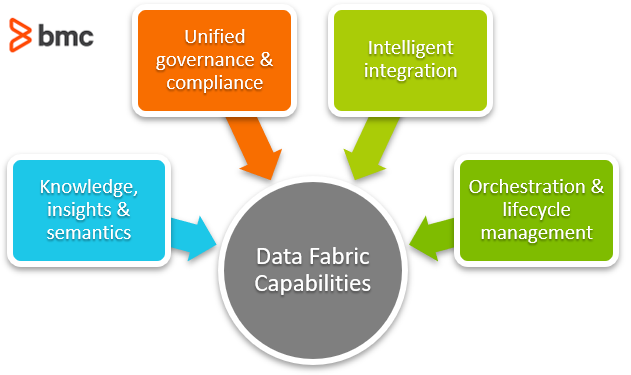Data Fabric Explained: Concepts, Capabilities & Value Props


Data fabric refers to the unified data management architecture and the set of capabilities that provide consistent capabilities to conveniently connect data endpoints and enable end-to-end data management capabilities.
Let’s take a look at the data fabric architecture.
Data assets are generated in silos and hidden across the hybrid mix of infrastructure environments. Data preparation cycles are long, and users need a broad set of data management capabilities to overcome the limitations facing complex multi-vendor, multi-cloud, and evolving data environments.
The data fabric architecture is designed specifically to address the challenges facing the complex hybrid data landscape.
Essentially, data fabric can be described as a converged platform supporting the diverse data management needs to deliver the right IT service levels across all disparate data sources and infrastructure types. It operates as a consolidated framework to manage, move, and protect data across multiple isolated and incompatible data center deployments.
As a result, organizations can invest in infrastructure solutions that align with their business requirements—without concerns surrounding data service levels, access, and security.

While traditional data management concepts such as DataOps are focused on the operationalization of large and distributed data assets, the Data Fabric is focused on capabilities that unify diverse and distributed data assets.
In simple terms, most organizations adopt frameworks such as DataOps to design, implement, and maintain a distributed data architecture. It helps make sense of data that is generated and maintained in a highly distributed infrastructure environment. By introducing a unified data management platform architecture such as Data Fabric, the end-to-end data management processes are combined, specifically:
(Learn about BMC's approach to DataOps.)
All tasks are managed within a single platform architecture designed to simplify access, management, and control over distributed data assets. A Data Fabric can include an array of data management capabilities across the following logical domains:
Data Fabric architecture is particularly useful in IT environments that involve dynamic data workloads distributed across geographically distributed infrastructure systems. Here’s how the Data Fabric architecture delivers value in the modern cloud-based enterprise IT setting:
When organizations invest in cloud storage and infrastructure solutions, their choice is based on cost, security, availability, scalability and service requirements. These requirements evolve over time, forcing them to either:
Cloud vendors, on the other hand, tend to lock customers into their service, making data migration a costly and challenging endeavor for their customers.
Data Fabric allows organizations to overcome the technical challenges in maintaining a diverse portfolio of data storage and infrastructure deployments. Customers can leverage the freedom to operate mission-critical data-driven IT services, apps, storage, and access from a range of hybrid IT infrastructure resources based on changing technical and business requirements.
Data Fabric is designed to mitigate disruptions from switching between cloud vendors and compute resources to process data stored in disparate locations. As a result, Data Fabric reduces time to insights dramatically. With faster insights, organizations can:
Better decisions through improved compute performance across all channels of data ensure that businesses leapfrog market competition while making the most of their data investments.
Organizations invest significant resources and efforts into delivering the best performance for their apps and services. This is especially true for mission-critical apps that may be required to process a growing volume of data as the user base grows or to accommodate unpredictable peak usage demands.
In order to address these demands, organizations must also invest in cloud storage solutions that promise the desired performance levels. Similarly, the app or service may evolve into a legacy solution of tomorrow and the usage requirement may reduce accordingly. Either way, the app should be capable of delivering predictable performance whether the data is available at either:
With Data Fabric, organizations can realize this capability and optimize their data investments based on evolving app usage requirements.
(See how usage requirements determine cold & hot storage.)
Data Fabric allows organizations the flexibility to adapt their infrastructure based on changing technology needs. Data Fabric makes it easy to connect various infrastructure endpoints to the consolidated and unified data management framework. Organizations don’t have to worry about the explicit location of the data.
If a startup firm invests in low-cost cloud storage solution until the company gains traction and needs highly available storage capacity at a later stage, it can leverage the flexibility that Data Fabric offers to choose infrastructure environments that best fit the nature of data and business requirements of the organization on an ongoing basis. The data management functionality will apply across all infrastructure deployments and organizations can future proof their data investments accordingly.
The Forrester New Technology: Projected Total Economic Impact 2020 study reveals the following business value of capabilities that make a unified Data Fabric architecture:
While these numbers are specific to the case example of the IBM Cloud Pak for Data, Data Fabric capabilities are relevant to all organizations running multi-cloud environments. Data Fabric offers organizations a range of business value propositions by addressing the technical challenges of operating data services in a multi-cloud and hybrid IT environment.